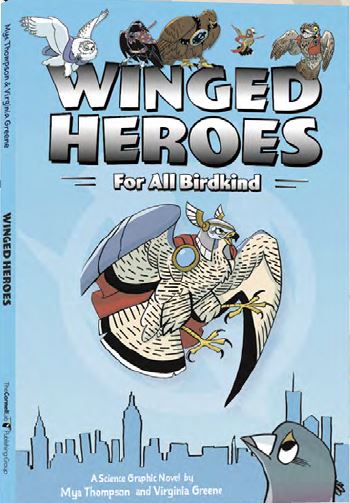Winged Heroes

In this graphic novel, we follow the journey of a Rock Pigeon through New York City and beyond, as he discovers and interacts with superhero birds, The Winged Heroes. Readers discover a blend of fantasy and reality in the stories of some common (but not ordinary!) birds.
Birds in This Book
- Peregrine Falcon
- Rock Pigeon
- Golden Eagle
- House Sparrow
- European Starling
- Wandering Albatross
- Ruby-throated Hummingbird
- American Crow
- Snowy Owl
- Osprey
- Common Potoo
- Canada Goose
- Carrier or Homing Pigeons are domesticated Rock Pigeon
Activity 3: CREATE A SUPERBIRD
- Explore the Cornell Lab’s Wall of Birds interactive to discover cool real birds.
Activity 4: CONSERVATION HEROES
- Explore the Lights Out, Seven Simple Actions, and other bird conservation projects (such as Fatal Light Awareness Program [FLAP] and Audubon) and to discover how humans can be heroes too!
Activity 7: PRACTICE YOUR FLIGHT
- Videos examples of diverse flight styles:
- Ruby-throated Hummingbirds flap their tiny wings incredibly quickly (53 beats per second) and are very maneuverable.
- Golden Eagles flap their wings slowly in flight (5 beats per second), but also soar without flapping for some time.
- House Sparrows consistently need to flap their wings in flight (about 15 beats per second).
Recommended Website:
- All About Birds: an online bird guide… so much great info about birds!
Related Lessons
- Check out this free Cooped Up Kids lesson plan on bird behavior, which features a slideshow for the kids with hands-on activities plus an educator guide.
- Teach your students about bird adaptations using our Cooped Up Kids lesson on bird anatomy to learn more bird body systems and what makes them unique.
Next Generation Science Standards
Third Grade:
- 3-LS3-2: Use evidence to support the explanation that traits can be influenced by the environment.
- 3-LS4-2: Use evidence to construct an explanation for how the variations in characteristics among individuals of the same species may provide advantages in surviving, finding mates, and reproducing.
- 3-LS2-1: Construct an argument that some animals form groups that help members survive.
- 3-LS4-3: Construct an argument with evidence that in a particular habitat some organisms can survive well, some survive less well, and some cannot survive at all.
- 3-5-ETS1-2: Generate and compare multiple possible solutions to a problem based on how well each is likely to meet the criteria and constraints of the problem.
Fourth Grade:
- 4-LS1-1: Construct an argument that plants and animals have internal and external structures that function to support survival, growth, behavior, and reproduction.
- 4-LS1-2: Use a model to describe that animals receive different types of information through their senses, process the information in their brain, and respond to the information in different ways.
- 3-5-ETS1-2: Generate and compare multiple possible solutions to a problem based on how well each is likely to meet the criteria and constraints of the problem.
Fifth Grade:
- 5-ESS3-1: Obtain and combine information about ways individual communities use science ideas to protect the Earth’s resources and environment.
- 5-PS3-1: Use models to describe that energy in animals’ food (used for body repair, growth, and motion and to maintain body warmth) was once energy from the sun.
- 5-LS2-1: Develop a model to describe the movement of matter among plants, animals, decomposers, and the environment.
- 3-5-ETS1-2: Generate and compare multiple possible solutions to a problem based on how well each is likely to meet the criteria and constraints of the problem.
CCSS Math Learning Standards
Third grade
- CCSS.MATH.CONTENT.3.MD.B.3: Draw a scaled picture graph and a scaled bar graph to represent a data set with several categories. Solve one- and two-step “how many more” and “how many less” problems using information presented in scaled bar graphs.
- CCSS.MATH.CONTENT.4.MD.A.1: Know relative sizes of measurement units within one system of units including km, m, cm; kg, g; lb, oz.; l, ml; hr, min, sec. Within a single system of measurement, express measurements in a larger unit in terms of a smaller unit. Record measurement equivalents in a two-column table.